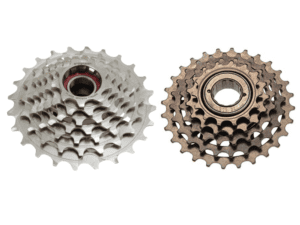There are a lot of choices to make when it comes to mountain biking, and one of the most important is what kind of frame material to choose.
Currently, two of the most popular options are carbon and aluminum, but which one is right for you?
In this post, we’ll compare the pros and cons of each material so you can make an informed decision.
Let’s get started!
Carbon vs. Aluminum Mountain Bike Frames – Is it Worth the Upgrade?
Carbon – Lightweight, Responsive, and Flexible Material
Carbon is a lightweight, high-strength material that comes in two varieties:
- Carbon fiber
- Carbon composite
It’s made of layers of fibers bonded together with resin under extreme pressure. This creates a stiff yet highly lightweight frame that won’t rust or corrode over time.
Carbon fiber itself is about 30% lighter than aluminum construction, so it takes less energy to get the wheels spinning, making climbing easier on rough trails.
In fact, carbon frames have long been touted for their superior ride qualities. It provides a comfortable ride over bumps and rough roads while remaining rigid in important places for efficiency.
The stiffness (or rigidity) offers improved power transfer since there’s no give when you pedal hard, which means more “oomph” on every push.
The downside to this stiffness is that it is more prone to damage, so carbon frames are more likely to break or crack under stress. A cracked frame means time off the bike for repairs!
Aluminum – Durable Material with Excellent Comfort Characteristics
Aluminum is a widely used mountain bike frame material.
The main benefits of aluminum mountain bike frames are their durability and good crash resistance. This is because aluminum bends rather than breaks—the complete opposite of carbon fibers—which reduces the risk of damage and downtime for repairs. So if you hit a rock or log head-on, your frame won’t crack.
Additionally, aluminum has better vibration damping than carbon due in part to its durability, enabling it to absorb shock and flex on impact excellently. It is a great choice if you find yourself riding over a lot of debris and rocks because it can reduce fatigue on longer rides.
Also, like carbon, aluminum doesn’t corrode or rust.
Carbon vs. Aluminum – Which Material is Right for You?
Carbon fiber mountain bike frames are built out of several different types of carbon fiber, each with its qualities.
Meanwhile, different methods of aluminum construction produce varying levels of strength and stiffness, but all have good durability and corrosion resistance.
Now, after covering the pros and cons of carbon fiber and aluminum, respectively, let us go into the specific differences between the two to help you decide which frame material is best for you.
Weight Difference
Mountain bikes have become heavier over time. Weight is being added in every suspension fork, disc brake, and rear suspension installed into it. Currently, the trend is to widen the wheels and tires—from 26-inch to 29-inch and 27.5-inch wheels—which in turn increases its weight.
There’s an old adage that says, “you may have cheap, good, or light. Choose any two of the three.” That adage certainly applies to mountain bikes. For example, a 15-pound mountain bike is the only one available at the store, but it will cost you a lot in carbon components that aren’t particularly durable if purchased.
Remember that carbon fiber bike frames and parts can weigh more than identical pieces made from other materials due to the smaller frame sizes and additional carbon layup required in the construction process.
Further, a medium-size aluminum hardtail frame (approx. 27 lbs) weighs the same as a small carbon hardtail frame (approx. 26 lbs). Likewise, a medium-size carbon full suspension frame (approx .29.5 lbs) weighs the same as an aluminum full suspension frame (approx. 30 lbs). Therefore, there usually isn’t a big difference in weight between an aluminum and a carbon full suspension frame.
The weight difference between carbon and aluminum is so tiny that it won’t make a significant difference in most cases. However, if you’re racing competitively or want to push your performance to the limit, then choosing a lighter frame might give you the edge you need to be faster on race day.
Feel When Riding
The ride feel of aluminum is more rigid, which can be great for riders who tend to go fast and hard on their equipment. In addition, aluminum absorbs less shock than carbon fiber, which results in a more responsive ride. This is something that some riders prefer because it provides better cornering on downhills and allows them to accelerate faster.
However, in terms of overall comfort, you may find carbon mountain bike frames far superior to aluminum. Keep in mind that aluminum mountain bike frames have varying amounts of comfort built into them, which makes it a challenge for a rider who prioritizes riding smoothness to decide on.
Carbon also has more stiffness compared to aluminum, which means you’ll get more power every time you pedal. Additionally, carbon absorbs more vibration than aluminum, which can reduce fatigue if you’re riding for extended time periods. This is why carbon is the most popular choice for road bikes and endurance mountain biking events.
Damping and Effect on Suspension
One of the main reasons riders choose aluminum over carbon is that it provides better shock absorption, resulting in a smoother ride on your mountain bike. The material absorbs shock and vibration, lessening hand and arm fatigue on long rides and decreasing the impact felt on your arms and legs from bumpy trails.
Carbon fiber also has superior damping characteristics, but some riders prefer aluminum’s stiffness to minimize the amount of “buzz” they feel on their hands and feet.
Carbon fiber can affect how smoothly your suspension functions because it’s a stiffer material than aluminum. However, some riders find this a slight inconvenience when climbing or accelerating since more power must be expended to flex the frame enough to gain traction.
Aluminum absorbs more shock, which results in increased traction while accelerating. The effect of carbon fiber on suspension varies depending on the type of riding you do. For example, carbon provides vibration damping for climbing that absorbs shock to maximize traction.
For descending, however, it tends to provide stiffness that results in better cornering and more responsive handling because the frame doesn’t flex much under braking or acceleration forces.
Material Selection for Moisture Resistance
When exposed to water, particularly salt water, aluminum corrosion can eventually degrade your mountain bike frame to the point where it falls apart in your hands. However, keeping your bike clean and well-maintained can significantly reduce this risk.
Many manufacturers protect their aluminum mountain bike frames with an anti-corrosion coating or treatment during construction, which reduces this risk even further—no matter what type of riding you do.
Carbon fiber is much more resistant to corrosion than aluminum, though it can still be damaged by exposure to saltwater and certain chemicals over time. Regular cleaning and waxing will help minimize this risk.
But if you regularly ride in dirty or wet conditions, your best bet may be to choose an aluminum frame instead.
Stiffness
Carbon provides significantly more stiffness than aluminum. This makes it the better choice for riders who prioritize power transfer and acceleration.
On the other hand, some riders prefer the rigidity of an aluminum frame because it allows them to precisely control their bike’s movements when cornering on downhills or navigating rocky terrain.
Note that stiffness doesn’t have any effect on how precise your steering may be. However, the flex that does occur in carbon can result in a more responsive ride over bumpy terrain. At the same time, some riders prefer aluminum, who find its rigidity preferable for precise control while descending.
Both materials are strong and durable, and stiffness can be considered as an added bonus to the mountain bike frame. You can’t go wrong with either material—it all comes down to your preferences on ride feel.
Durability
Aluminum is more durable than carbon fiber under normal riding conditions. Aluminum mountain bike frames are more likely to bend than break following an accident, and this usually happens when the frame has already sustained some sort of damage.
Meanwhile, carbon fiber requires special care during installation and while transporting your ride on a vehicle rack. The material is also more susceptible to damage through rocks and other trail obstacles.
For these reasons, aluminum is preferred for beginners who may not have perfected their body positioning or stance while descending yet. In fact, plenty of riders at all levels prefer aluminum because it’s easier to repair in case of an accident or to modify.
Either material can be very durable if it’s chosen and maintained correctly. Aluminum is the more affordable material choice, and repairs are easier to make, but carbon’s rigidity gives it an advantage in power transfer.
Price
Aluminum is less expensive than carbon fiber, and many riders agree that the material’s durability and vibration damping characteristics outweigh any increase in stiffness. As a result, aluminum has become the most popular frame construction material for mountain bike frames.
Carbon fiber, on the other hand, is more expensive than aluminum, but it’s lighter in weight and provides increased stiffness that improves power transfer and acceleration. This makes it the preferred choice for competitive riders who ride hard on descents.
Other Factors
Manufacturers use different grades of carbon or aluminum, and not all frames are equally durable. There are also other factors that may affect the quality of the frame you’re going to purchase, including:
- How it’s made (for example, if bonding or welding is used during assembly)
- What type of riding you are doing (more frequent descents take their toll on any material)
- How often you are cleaning and waxing the bike
- What parts you are choosing to upgrade or modify over time
Carbon fiber mountain bike frames can last for many years with proper care—and sometimes longer, depending on how they’re constructed. Aluminum may require more care during installation, but it’s less expensive than carbon fiber options–and easier to repair if something happens.
FAQs
What is the best material for a mountain bike frame?
It depends on its intended usage, which varies from rider to rider. For example, some riders prefer carbon fiber frames due to increased stiffness and power transfer. Meanwhile, others prefer aluminum as it offers a more comfortable ride due to its better shock absorption.
Why do many mountain bikers prefer aluminum frames?
Aluminum mountain bikes suit trail riders who want a durable frame that can handle rough terrain without bending or breaking. The durability makes it a good choice if you’re going off-road frequently and tend to be hard on your equipment. It also has better vibration damping than carbon fiber, which some riders prefer in a mountain bike frame.
Also, some aluminum frames absorb shock better than many carbon-fiber models—the material’s specific makeup varies from brand to brand and model to model. Aluminum also tends to have a more cushioned ride because of this feature without compromising the power transfer or responsiveness during acceleration.
Is aluminum or carbon fiber stronger?
Both materials are strong and durable, although aluminum is more likely to bend in a crash. Carbon fibers also have a tendency to break during sudden impacts if it’s not manufactured correctly.
In general, both materials have an edge over the other when it comes to durability—carbon being stiffer but more fragile and aluminum being better at shock absorption and bendability.
How long will a carbon fiber mountain bike frame last?
It depends on a number of factors, including intended riding style and how it’s cared for. A carbon fiber frame made from one of the industry-leading brands can last beyond 10 years.
A new rider who only hits the trails on occasion may notice that their carbon-framed bike needs replacement after as little as four or five years, while expert riders who descend frequently might need to replace their carbon-fiber mountain bike within three years.
Conclusion
Carbon fiber provides a stiffer ride that improves power transfer and is ideal for riders who prefer these characteristics.
Aluminum mountain bike frames absorb more shock from bumps in the road, resulting in a smoother ride over rocks and other obstacles. This smoothness can be advantageous when ascending or accelerating.
The material’s increased stiffness makes it the better choice for some riders who prefer precise control over their bike’s movements while descending. And it is carbon fiber that provides ample stiffness that allows for precision steering with proper body positioning.
Remember: just because a mountain bike has a carbon fiber frame doesn’t mean it’s better than one with an aluminum frame. Both materials have their benefits and serve particular purposes, so it’s best to choose the one that matches your intended use and suits you best!





